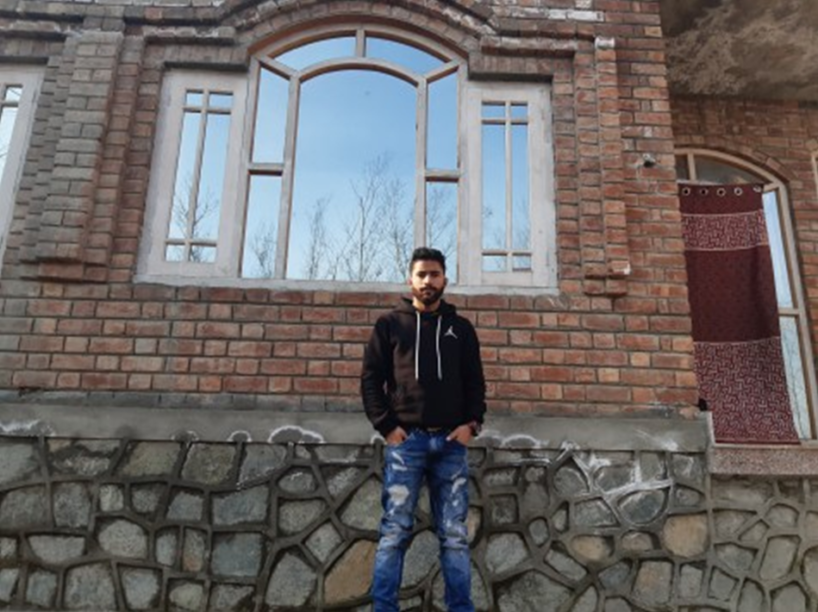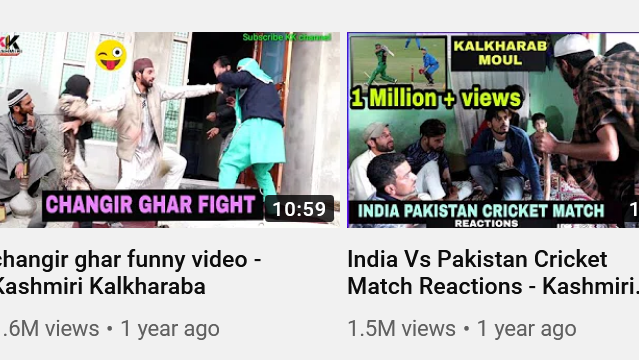Yawar Ahmad Wani is sitting despondently against the backdrop of over a dozen trophies, his smartphone on silent. “We are the pioneer YouTubers [in Kashmir],” said the 19-year-old co-founder of Kashmir’s biggest YouTube channel, Kashmiri Kalkharabs (“Crazy Kashmiri”). “We made the scene without anyone’s help. We did it on our own.”
For the last 197 days, he’s woken up cranky, restarting his smartphone to cross-check the internet restoration rumours. “I have dreams where I’m using the internet,” he said. “That feeling is surreal—but as soon as I wake up, I realize we are still locked down.” There’s been a partial restoration of services, but for now service is still too slow for streaming.
On 5 August 2019, the central government scrapped the decades-old agreement granting the region’s partial autonomy and divided—and downgraded—the former state into two federally-governed territories: Jammu and Kashmir (J-K) and Ladakh; it also snapped all lines of communications in J-K.
Considered separately from authoritarian countries like China and Myanmar, the ongoing Internet blackout in Kashmir Valley is the longest in any democratic governance ever; it has left young Kashmiris, who’d been using YouTube as a tool of emancipation, in a miserable condition.
After 2016, the Jio network entered the mobile services market and changed the way people access the internet in India. The effect also reached Kashmir and within a year or two, numerous home-grown popular channels sprang up, producing varied content from comedy acts to regional recipe shows to independent music.
The Kashmir Walla sat down with YouTubers from different walks of life to understand how the internet clampdown has affected their lives.
Tragedy in Comedy
Kashmir’s comedy, or vines, scene can find its roots in an extended family living in the outskirts of Srinagar, in Shalteng. Two brothers among five siblings, in a family of seven, run two of the most popular channels—Kashmiri Kalkharabs and Ultimate Rounders.
One day in December 2016, the youngest in the family, Mr. Wani, then 16, was laughing out loud at the streetside jokes of his maternal cousins, Pervez Ahmad Bhat and Showkat Ahmad Mir.
“Why not shoot it?” Mr. Wani had wondered. “I just posted it randomly on YouTube and within a week it was everywhere.”
The viral video gave them confidence and an idea emerged—Kashmiri Kalkharabs. Starting from scratch, a smartphone camera, a minimal video editor, and socially-conscious humor in Kashmiri language—“which is a deliberate attempt to save our culture”—was all that the cousins had. And it totally rang with Kashmir.
Soon, the channel subscribers rose and Kalkharabs became first channel to touch the Silver Button mark of one lakh (100,000) subscribers. Their most popular video has been watched more than 1.6 million times. Today, they are the biggest channel in Kashmir with more than four lakh and seventy-four thousand subscribers.

While Mr. Wani wrote and acted for Kalkharabs, back at home, for the next two years, his elder brother, Ishfaq Ahmad Wani, 26, drove buses for numerous schools to support his carpenter father and homemaker mother. In awe, he watched his younger brother’s channel grow like anything.
In December 2018, in an attempt to try his hand at acting, elder Wani founded his own channel: Ultimate Rounders. Following the same path, guided by younger Wani, the Rounders too made a name in Kashmir’s YouTube space, with more than one lakh subscribers.
Seeing success coming his way, elder Wani ditched the wheels and took up acting as a full time gig.
By end July 2019, Kalkharabs employed six actors and was able to mint about seventy thousand rupees a month from AdSense, while Rounders has employed five actors and was able to mint thirty thousand rupees.
“I was going to get married in the upcoming April,” elder Wani said, sitting inside an overexposed room wearing a dusty grey sweater. “If the internet is not restored soon, I need to look for an alternative job.”
“YouTube had endless possibilities. It was like I could do anything. I was the most powerful man. I felt empowered. Now, I feel like a labourer without legs.”
Many YouTubers like the Wanis are sitting at home helpless and idle, and thinking of looking for an alternative living.
One of the five co-workers at Rounders had flunked a subject in tenth grade as he was “all into YouTube and thought of making a career out of it.”
Younger Wani, sitting next to his elder brother, sporting an oiled moustache, said that everyone in the room awaits the restoration of internet services like the pious await Eid crescent. “But Eid isn’t coming,” younger Wani laughed.
According to internetshutdowns.in, which tracks Internet cuts across India, from 2012 to 2018, the Indian government has imposed a total of 180 internet shutdowns in Kashmir; this year alone, there have been a total of 55 internet shutdowns so far.
From the monthly earning of thirty thousand rupees, Mr. Mir, who had co-founded Kalkharabs, was looking after his family of seven, including his two daughters, three and five years old. To make sure that his daughters don’t sleep hungry, he “moved on from YouTube and started trading rice in south Kashmir in September.”
“The government doesn’t know we exist,” younger Wani said. “They don’t know people make a living from YouTube.” Even the restoration of broadband internet services won’t be of any help to these YouTubers because their entire audience depends on mobile Internet services.
The Wani brothers grew up watching their father running a wood-log to and fro on a machine to bring money home. Life expected them to take up a minimal job and maintain the responsibilities of the family. For them, YouTube was a chance of getting out of the “poverty-circle”; for once, while shooting acts, the brothers felt emancipated.
“Now, I feel like a zero,” elder Wani sighed.
“Missing Independent Vibe”
Unlike the Kalkharabs and Rounders, who looked at YouTube as a tool to make people laugh and mint money, Tassiya Tariq, 26, was uploading recipes to her YouTube channel, Kashmir Food Fusion, “to teach a younger generation—how to cook Kashmiri food?”
“Young girls found their inspiration in me. But, the frequent internet shutdowns have caused us losses. YouTubers outside Kashmir are racing ahead of us.”
Back in 2015, after she completed her Masters in Arts from IGNOU, Tariq married a food inspector, working with a government department. When people around her initially rejected the idea of a food-based YouTube channel, she found her support, and producer-cum-cameraperson, in her husband.
 Photograph by Yashraj Sharma
Photograph by Yashraj SharmaSince her start in January 2018, Kashmir Food Fusion has grown to more than forty-five thousand subscribers. Tariq had also found sponsors like Peer Mustard Oil, who would market their product to her audience.
To start with, she couldn’t think of anything better than traditional wazwan, which she had learnt from her family cook, or waza. In the past two years, she’s derived her focus from the two-way communication model of her channel, interacting with viewers to ensure she is responsive to audience demands.
As her 2-year-old daughter, Aisha, punched a red balloon in the air in the cold Srinagar weather, Tariq told us, “[Post 5 August] my channel is totally shut. Earlier, people were recognising my work and it felt good. It was a feeling of empowerment. Now, I miss the independent vibe.”
When the internet is restored—if ever, she wonders—Tariq would have lost not only on the immediate financial front, but in the quality of consumer relationships and in the trust of sponsors, as well.
“Indeed, it feels sad – very sad”
In Delhi, Mir Gazzanfar, 29, has been forced by the clampdown to take up a steady job in a digital marketing company. But back in Kashmir he is one of the first hip-hop artists, locally known as EssXaar.
In the politically charged hip-hop environment of the Valley, Gazzanfar said that he “chose conscious music, and not political, to sound different.” Over the years, the scene depleted—with most of the pioneers leaving music to pursue alternative careers, slowly fading away. In the absence of a rock-solid music industry in the Valley, the artists made an independent scene, but haven’t developed the proper mechanism to monetize it.
Gazzanfar’s work swings between bling-bling hip-hop and fusion of Kashmiri folk with his own verses. The clampdown hasn’t been able to cut through his passion for music, but has halted his ideas for sure. He was able, to some degree, to make money through his YouTube audience. But, he says, “more than eighty per cent of them are Kashmiri,” so dropping new songs doesn’t make sense to him.
A day prior to the clampdown last August, Gazzanfar had taken out the final mix of a new song, with half of the video shoot done. With more plans in basket, the internet blackout has held his feet tight and dragged him to Delhi, looking for a job to stay afloat.
“Indeed, it feels sad—very sad. Music was something that I had in my heart,” he said. “[The government] didn’t do right. Does anyone say it is right? From online businesses and students to artists, everyone is suffering because of them.”
2019 has ended, and there is no official word around internet restoration other than statements claiming it would be done in a “phased manner.” There are rumors, but apparently no one is answering when, or how.
Published in arrangement with The Kashmir Walla.






